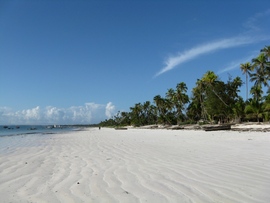|
For this blog entry, we diverge from the savannas of northern Tanzania and the burned forests of the western US to take you to the coral reefs of the Western Indian Ocean - specifically, the magical islands of Zanzibar located 25-50 kilometers off the eastern coast of mainland Tanzania.  Zanzibar is world-famous for its exotic spices, intriguing history, and stunning white-sand beaches. But one of the most fascinating aspects about the island is what lies hidden beneath the gentle waves that lap her shore. Mangrove forests fringing the island act as a nursery for fish. Seagrass beds and lush coral gardens teem with tropical fish, and in deeper waters larger species such as barracuda, kingfish, tuna, and wahoo hunt together with Napoleonic wrasse, manta rays, sharks, and dolphins. These reefs support literally hundreds of species of hard and soft corals and fish as well as sea turtles, crustaceans, and marine mammals. The coral reefs that surround Zanzibar are in generally good condition but are showing some troubling signs of stresses similar to other reefs in the Western Indian Ocean. These stresses include overexploitation, destructive activities (fishing and anchor damage), and pollution. An additional threat includes the spread of a predator known as the Crown-of-Thorns sea star (click here for more information). We recently visited Chumbe Island Coral Park and Mnemba Marine Park. Enjoy a short underwater video and some photographs we took of these incredible reefs.
0 Comments
Your comment will be posted after it is approved.
Leave a Reply. |
Science News and Updates From the Field from Wild Nature Institute.
All Photos on This Blog are Available as Frame-worthy Prints to Thank Our Generous Donors.
Email Us for Details of this Offer. Archives
July 2024
|
|
Mailing Address:
Wild Nature Institute PO Box 44 Weaverville, NC 28787 Phone: +1 415 763 0348 Email: [email protected] |
|

 RSS Feed
RSS Feed
